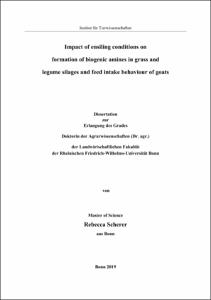Scherer, Rebecca: Impact of ensiling conditions on formation of biogenic amines in grass and legume silages and feed intake behaviour of goats. - Bonn, 2019. - Dissertation, Rheinische Friedrich-Wilhelms-Universität Bonn.
Online-Ausgabe in bonndoc: https://nbn-resolving.org/urn:nbn:de:hbz:5-54529
Online-Ausgabe in bonndoc: https://nbn-resolving.org/urn:nbn:de:hbz:5-54529
@phdthesis{handle:20.500.11811/7991,
urn: https://nbn-resolving.org/urn:nbn:de:hbz:5-54529,
author = {{Rebecca Scherer}},
title = {Impact of ensiling conditions on formation of biogenic amines in grass and legume silages and feed intake behaviour of goats},
school = {Rheinische Friedrich-Wilhelms-Universität Bonn},
year = 2019,
month = may,
note = {Silage produced from small-grained legumes can contribute to the protein supply of ruminants. However, the susceptibility to protein degradation during harvest and the entire conservation process impedes to achieve high feed quality. The changes in the composition of crude protein fractions from protein nitrogen to non-protein nitrogen, which encompasses amongst others biogenic amines, are assessed negatively for several reasons, as they may result in a reduction of feed intake.
The aim was to determine the effect of ensiling conditions on formation of fermentation products with focus on biogenic amines and the resulting feed intake behaviour and the short-term dry matter intake (DMI) of silages by goats. Moreover it was examined whether the preference for one of two forages on offer develops immediately at the beginning of feeding based on the emanating odors or whether the feed has to be ingested in order to activate the postingestive feedback. Six silages with different treatments were produced each from lucerne (Medicago sativa L.), red clover (Trifolium pratense L.) and ryegrass Lolium multiflorum LAM.). After ensiling of at least 90 days, preference trials with Saanen-type goats (n = 8 for lucerne and red clover silages and n = 6 for grass silages) and a comprehensive chemical characterisation were carried out. During the experimental phase, each possible two-way combination of the six silages and lucerne hay, which served for comparison of different runs, was offered as free choice for 3 h. The first three minutes of feeding were filmed to analyse the behaviour towards the two offered forages.
The results revealed that intense proteolysis did not result in high contents of biogenic amines. Within the determined concentration range (1.2–4.1 g/kg DM) no influence on feed intake behavior was found. In addition, the crude protein fractions and the fermentation products could not clearly be attributed to influence the DMI. The DMI of the treatments differed significantly within the plant species. However, the DMI rankings of the three plant species were very similar. The preference of goats for one of the two freely selectable silages was already shown during the first few minutes of feeding. The behavioural observation by means of video recordings over a very short period of time thus seems to be suitable for assessing the development of preference when presenting two silages.},
url = {https://hdl.handle.net/20.500.11811/7991}
}
urn: https://nbn-resolving.org/urn:nbn:de:hbz:5-54529,
author = {{Rebecca Scherer}},
title = {Impact of ensiling conditions on formation of biogenic amines in grass and legume silages and feed intake behaviour of goats},
school = {Rheinische Friedrich-Wilhelms-Universität Bonn},
year = 2019,
month = may,
note = {Silage produced from small-grained legumes can contribute to the protein supply of ruminants. However, the susceptibility to protein degradation during harvest and the entire conservation process impedes to achieve high feed quality. The changes in the composition of crude protein fractions from protein nitrogen to non-protein nitrogen, which encompasses amongst others biogenic amines, are assessed negatively for several reasons, as they may result in a reduction of feed intake.
The aim was to determine the effect of ensiling conditions on formation of fermentation products with focus on biogenic amines and the resulting feed intake behaviour and the short-term dry matter intake (DMI) of silages by goats. Moreover it was examined whether the preference for one of two forages on offer develops immediately at the beginning of feeding based on the emanating odors or whether the feed has to be ingested in order to activate the postingestive feedback. Six silages with different treatments were produced each from lucerne (Medicago sativa L.), red clover (Trifolium pratense L.) and ryegrass Lolium multiflorum LAM.). After ensiling of at least 90 days, preference trials with Saanen-type goats (n = 8 for lucerne and red clover silages and n = 6 for grass silages) and a comprehensive chemical characterisation were carried out. During the experimental phase, each possible two-way combination of the six silages and lucerne hay, which served for comparison of different runs, was offered as free choice for 3 h. The first three minutes of feeding were filmed to analyse the behaviour towards the two offered forages.
The results revealed that intense proteolysis did not result in high contents of biogenic amines. Within the determined concentration range (1.2–4.1 g/kg DM) no influence on feed intake behavior was found. In addition, the crude protein fractions and the fermentation products could not clearly be attributed to influence the DMI. The DMI of the treatments differed significantly within the plant species. However, the DMI rankings of the three plant species were very similar. The preference of goats for one of the two freely selectable silages was already shown during the first few minutes of feeding. The behavioural observation by means of video recordings over a very short period of time thus seems to be suitable for assessing the development of preference when presenting two silages.},
url = {https://hdl.handle.net/20.500.11811/7991}
}






